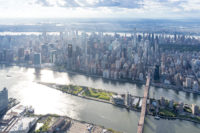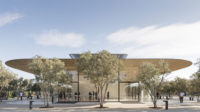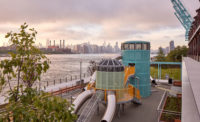Speaking at the 2012 convocation ceremony at Cornell University’s Ithaca campus, then New York City mayor Michael Bloomberg called upon graduates to take part in what he referred to as “one of the most exciting projects ever to take shape in New York City’s history”: a new, 12-acre graduate level tech campus and entrepreneurial hub on Roosevelt Island, the mostly underdeveloped strip of land on the East River, between mid-Manhattan and Queens’ Long Island City neighborhood.
“All of you engineers, computer scientists, and techies who are thinking about heading west to Silicon Valley: if you really want to experience life...if you want to have a date whose name is not Siri, come to New York City,” he proposed.
Just five months prior, the Bloomberg Administration selected Cornell, along with the Technion—Israel Institute of Technology, to partner with the city for the development of the state-of-the-art campus. The goal of the $2 billion initiative, called Cornell Tech, is to bridge the gap between academia and practice, and to refashion the city as a 21st century tech mecca.
Today, Bloomberg, along with elected officials including Governor Andrew Cuomo and Mayor Bill de Blasio, as well as Cornell president Martha Pollack and other university representatives, gathered at the new campus for the official dedication of its first phase, which includes a 160,000-square-foot academic building called the Bloomberg Center, designed by Morphosis Architects, a 235,000-square-foot center for entrepreneurial research known as the Bridge, by Weiss/Manfredi, and a 26-story residential building by Handel Architects. Skidmore, Owings, & Merrill designed the campus master plan.
“Technological innovation must continue to play a central role in order for New York City to remain a global economic capital,” said Bloomberg at today’s opening ceremony. “This campus will help ensure that.”
“In New York, we would say this is a mitzvah,” said Governor Cuomo of the project.
Cornell Tech, which now has a total of 300 students, has just begun to occupy the Roosevelt Island campus; it had been temporarily based out of Google’s offices in Manhattan’s Chelsea neighborhood since starting up in 2012. Within the past five years, the university annex has sprouted 38 start-up companies—93 percent of which are headquartered in the city.
Fundamental to its new campus is collaboration: both the Bridge and the Bloomberg Center are defined by open plans, idiosyncratic circulation paths, generous glazing, and dynamic cantilevers, allowing visual access across peripheries and out onto the skyline, and, it is hoped, encouraging users to make physical connections and naturally engage with one another.
“This may be the only university facility in the world with no private offices for professors—and that is a feature, not a bug,” Bloomberg said of the building for which his foundation donated $100 million. (During his time at City Hall, he was known to sit at an open desk alongside his aides.)
Sustainability is also a core consideration. Handel Architects designed the residential tower as the first-ever passive house high-rise in the United States, while the Bloomberg Center is aspiring to operate at net-zero energy. The Bridge, too, offers a number of highly energy efficient features—for instance, its envelope is 40 percent transparent, dramatically reducing the need for artificial lighting. Photovoltaic panels cover the roofs of both academic and research buildings.
Another aim of the campus is to open up Roosevelt Island to the public—and to bring the city onto university grounds—with its landscape (designed by James Corner Field Operations), which offers sweeping east-west vistas.
According to Governor Cuomo, it seems fitting that Cornell Tech cohabits the island with the Louis Kahn-designed FDR memorial to the south. “Cornell Tech embodies Franklin Delano Roosevelt’s sense of possibility,” he said. “It is a powerful symbol of opportunity at a time when many are frightened about their economic future.”










